Welcome to the 13th edition of First Nations News & Views. This weekly series is one element in the “Invisible Indians” project put together by navajo and me, with assistance from the Native American Netroots Group. Our last edition is here. In this edition you will find an exploration the Elizabeth Warren imbroglio, a look at the years 1877, 1916 & 1969 in American Indian history, three news briefs and some linkable bulleted news briefs. Click on any of the headlines below to take you directly to that section of News & Views or to any of our earlier editions.
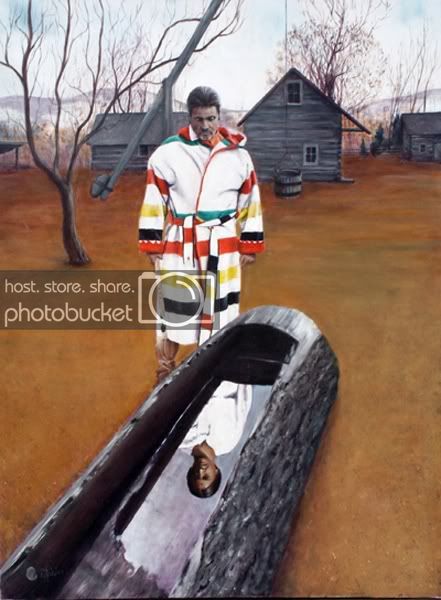
The outpouring of right-wing outrage over the revelation that Senate candidate Elizabeth Warren had checked the “Native American” box in directories of the Association of American Law Schools has followed a familiar trajectory. No surprise since it’s election campaign season. Given the right’s modern efforts to destroy or at least undermine tribal sovereignty and extinguish Indianness altogether, the racist hypocrisy exhibited in the accusations that Warren was lying and, in the words of Japanese internment praiser Michelle Malkin, playing “oppression Olympics” sent more than one Indian on a hunt for a barf bag.
On the other hand, Warren’s stated reasons for having made professional note of her Native heritage are hard to swallow. Other than that Cherokee great-great-great-grandmother listed on a 19th Century marriage certificate, her connection to Indians is tenuous. There is a cousin deeply involved in Cherokee affairs and Native causes in general. Warren, however, isn’t enrolled in any of the Cherokee bands, she doesn’t speak the language, she doesn’t go to ceremonies or otherwise practice the culture, she never made an attempt to discover who that three-greats grandmother really was, she doesn’t hang around other Indians, she apparently has never attended a conference on Native law to network with Indians as she has said was trying to do when she checked that box, and she has made no effort that anyone has unearthed to speak to Indians about their legal and political concerns or for them in public forums. The reality for her seems to be that a mantle photo of her grandfather showed him with “high cheekbones.” Well, I have those, too. But it is hard to call someone with that background an Indian, Cherokee or otherwise.
What Warren did is widely known as “box checking.” Assigning oneself Native heritage on job applications and elsewhere even if that heritage is no more than family legend. For some, and this is especially true in Oklahoma, making note of an American Indian in the family tree is perfectly innocent and accurate even if there is no real evidence and no current connection. Some individuals lie outright and go further. The tribe-shopping Ward Churchill made claims to be Creek and Cherokee – claims he made to my face in the late 1970s – but could provide no evidence of Indian ancestors in any tribes back the six generations that investigators could trace documents.
He and others falsely claiming such ancestry, by checking boxes or more elaborate means, may do so for personal benefit. That is, of course, what Warren’s detractors say. Others may make the claim out of real pride, in remembrance of a grandparent or more distant ancestor whom they know for sure was Indian or have been told was so in family lore.
[Box-checking] was precisely what the Coalition of Bar Associations of Color was getting at when they passed a “Resolution on Academic Ethnic Fraud” last July. The resolution, signed by the presidents of the Hispanic, Asian, Native American and National bar associations, states, among other things, that “fraudulent self-identification as Native American on applications for higher education … is particularly pervasive among undergraduate and law school applicants.”
It goes on to say the phenomenon is “so pervasive, it is commonly understood and referred to within the Native American Community as ‘box-checking.’”
It’s clear that Warren didn’t lie. She does have a Cherokee ancestor. And, if that long-dead woman was a full-blood, that makes Warren 1/32nd Cherokee, the same as the current Principal Chief Bill John Baker of the Cherokee Nation, which has some 317,000 enrolled members. But Baker has never been disconnected from his heritage, which includes well-known Cherokees. His great-great-grandmother was orphaned when her parents died on the “Trail of Tears,” the infamous death-march of the Cherokees from their homes in the Southeast to Indian Territory, now Oklahoma where both he and Warren were born.
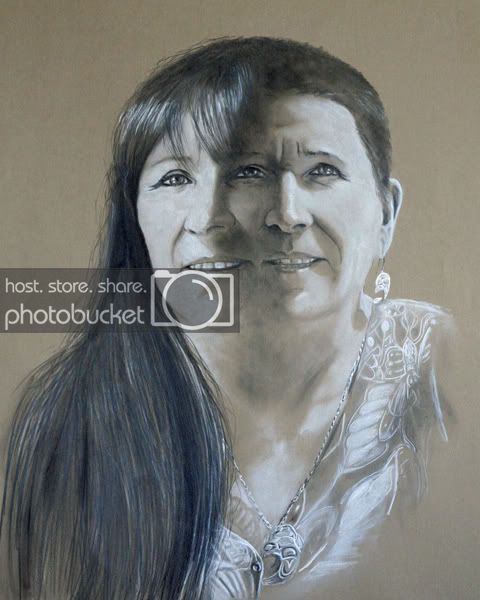
His ancestors are on the Dawes Rolls, on which Cherokee, Choctaw, Creek, Chickasaw, Oklahoma Seminole and some Florida Seminoles were enumerated. So far, nobody has found a Warren ancestor on the Dawes Roll. That doesn’t mean there isn’t one there. And it doesn’t mean More than a quarter-million people applied to be included. Fewer than a 100,000 actually made it. People were chosen to be listed by whites who inspected their appearance. In some cases a brother was included and another was not. One unstated goal of the rolls was to exterminate Indian identity after the period of actual slaughter had ended. Thus, many who legitmately claimed Indian blood were denied a listing. Warren’s ancestor could easily have been one of those. If one is found, she could apply for membership in Cherokee Nation. Any amount of “blood quantum” is acceptable to those on the Dawes Rolls. Without that connection, however, she is not legally an Indian.
What’s unclear is whether Warren checked the “Native American” box solely out of pride or because it might perhaps give her a one- or two-percent edge over some other job candidate without that heritage. She says she didn’t. She says, in fact:
“I listed myself in the directory in the hopes that it might mean that I would be invited to a luncheon, a group something that might happen with people who are like I am,” she said. “Nothing like that ever happened, that was clearly not the use for it and so I stopped checking it off.”
This sounds like after-the-fact excuse-making to me. But there is no evidence contradicting her. And Warren has a record for being a straight-shooter. So one either takes her at her word on this or not, assigning it small or great significance depending on one’s point of view about the rest of her career.
What Warren also didn’t do, however, was step up in 1996 when it became clear that Harvard, under pressure from students and others about the lack of diversity on its law faculty, was touting her Native heritage in order to be able to claim another minority professor. What Harvard did was despicable. What Warren didn’t do enabled Harvard to get away with it. She was wrong, very wrong, to let that pass. It was an error in judgment, the kind of thing many, many people make in their lives. Was it also a moral lapse? Perhaps.
But the fact of the matter is Warren is a pre-eminently qualified person to be a Harvard professor of law. And she has demonstrated repeatedly and courageously against elected politicians and political appointees that she stands up for the average American, the ones on the precarious edge of economic existence today, against the austerity-mongers and New Deal-dismantlers and tax-cuts-for-the wealthy/program-cuts-for-everybody-else crowd that have grasped the nation by the short hairs and refuses to let go. Her opponent is a lite version of that crowd. Which is why – my finger-wagging over her box-checking and clumsy campaign response to its revelation aside – I was glad to see her enter the Senate race, have contributed money to her and will continue to do so, and would vote for her enthusiastically if I lived in Massachusetts.
The focus on Warren has done something that always has some value: made us invisible Indians visible. Of course, that has elicited gobs of the usual racism, like this putrid column by Howie Carr in the Boston Herald, whose only redeeming feature is that it didn’t actually make a joke about “injuns” or “Redskins.” But the Warren affair also provides the opportunity to explain to non-Indians what Indianness is about.
What it is not about is appearance. Not about skin tone. Not about high cheekbones. Not about looking like somebody in an Edward Curtis photograph. As I wrote previously in a comment in Joan McCarter’s excellent diary about what Warren should do campaign-wise regarding this flare-up, I am a white-looking tribally enrolled Seminole, with about 3/8s Indian blood. At reunions when the older generation of my extended family was alive, people went from lighter than me to as dark as Michelle Obama. All of us Seminole, all of us related by blood. Many tribal chiefs today, are light-skinned with a mix of Indian and European or Indian, European and African blood. In fact, most tribally enrolled Indians today, on and off the reservations, are mixed bloods. They can look very non-Indian but be thoroughly Indian culturally.
Most of us, on or off the reservation, are cultural hybrids. We may or may not have an Indian-sounding name. When we do, it is typically a translation, like Deborah White Plume (Oglala-Lakota). We, or our ancestors may have adopted a non-Indian religion. Or, there too, we may practice a hybrid, or stick exclusively to a clearly defined Native religion. Or we may, like a significant portion of other Americans, practice no religion at all. My partner in this series, navajo, as she has written, was raised a Mormon. I was raised a Catholic and subsequently a Lutheran. We both abandoned those religions decades ago.

Most of us Indians speak English and no longer speak the language of our ancestors beyond a few words or expressions. Among the Navajo and the Cherokee and Lakota, however, fluent speakers are numerous, and efforts have been made to educate the younger generation in the Native tongues, a counterweight to decades of boarding schools that did everything they could to crush those languages. To age 9, I spoke the Seminole Creek dialect just to be able to communicate with my grandmother, my surrogate mother for those first years, because she would not speak English even though she understood it perfectly from her boarding school days. Over the years, I have lost almost all of it, which is the case with most Seminoles in Florida and Oklahoma today. navajo never was taught her language, although she has made attempts to learn in the past 10 years.
About half of people identifying themselves as American Indian today were born on or near reservations, but many of us who were not have a strong connection to reservation life. But others were not and do not. Yet they maintain a strong Indian identity. A modern identity. One shaped by our unique personal stories, by our tribal history and the entangling interactions of both these with others of our own tribe and the tribes of people whose histories are far different, and with the dominant culture and other sub-cultures of the American populace.
Whether we live on or off the reservation, in an urban or rural setting, whether we speak the language or not, whether we’re tribally enrolled or for various reasons not, we have one thing in common, we are connected to other Indians and we are appalled at how dreadful the existence of so many of our brothers and sisters remain 120 years after the last massacre of our people. We seek a better life for us all, on our collective and individual terms, blending or separating, but never forgetting how we can to be who we are 20 generations after Columbus arrived.

By Meteor Blades
On May 5, 1877, nearly a year after Lakota and Northern Cheyenne and Northern Arapaho warriors stunned the United States by wiping out five of the seven companies Lt. Col. George A. Custer’s regiment at the Battle of the Greasy Grass, the man who saw a vision of it beforehand – “soldiers falling into his camp like grasshoppers from the sky” – Tȟatȟáŋka Íyotake, Sitting (Buffalo) Bull (Lakota-Hunkpapa) – led his beleaguered people across the border into Canada.
Knowing full well that their victory against the 7th Cavalry would bring down the Army’s wrath, the various bands making up the great encampment in Medicine Tail Coulee had scattered within 48 hours, hoping to make the job of revenge more difficult. In the next months, the Army clashed mercilessly with these bands and forced thousands of Indians back onto reservations at gunpoint. It was the beginning of the end of the Indian wars, and these POWs were treated in ways that would make the drafters of the Geneva Conventions shudder.
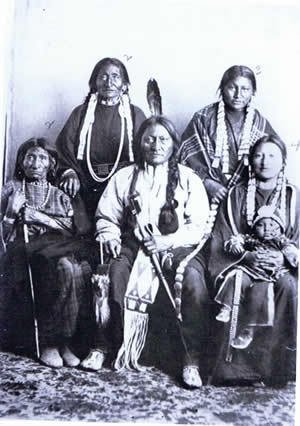
seated, and two of his wives (date unknown)
Sitting Bull’s band of Hunkpapas had managed to evade the troopers, however, with only minor clashes. They hunted the dwindling buffalo herds all summer. In late autumn, Gen. Nelson A. Miles met with him and demanded that he surrender. Sitting Bull knew the odds and he wanted no more fighting. But he was to his dying day a proud man and, as victor, he thought he should be dictating terms.
That caused Miles, who had defeated the Kiowa and Southern Arapaho and Southern Cheyenne two years earlier, to step up his actions. Sitting Bull decided to strike out for what the Indians called the “grandmother’s land,” named for Queen Victoria.
They remained there for four years. At first, all went well. The Canadian government was not on a campaign to wipe out the buffalo as a means to destroy Indian culture and game was plentiful. But his warriors got tired and started needling other tribes in the area. That brought the Royal Canadian Mounted Police into the picture. They pressured Sitting Bull to go home and take his young troublemakers with him. With the nomadic buffalo falling prey to hunters and habitat shrinkage from ever more white settlers in the States, the effect of their extermination soon became felt farther and farther north, and times became tougher. Many of the band gave in to emissaries who said reservation life in the U.S. was better than what was becoming a hand-to-mouth existence in Canada.
By 1881, Sitting Bull’s band was made up mostly of the old and sick, and he reluctantly surrendered in July, with just 187 others. After a few transfers, he the rest were incarcerated at Fort Randall in southeastern South Dakota for the next two years. They were allowed to return to the Standing Rock Agency (the Lakota reservation that now straddles North and South Dakota) in mid-1883.

On May 5, 1916, U.S. Army Indian Scouts, all of them Apaches, were part of what some claim is the “last cavalry charge” against Mexican revolutionary Pancho Villa at Ojos Azules ranch in the state of Chihuahua, Mexico. They were an element of the 11th Cavalry, which had entered Mexico as part of Gen. John J. Pershing’s Punitive Expedition.
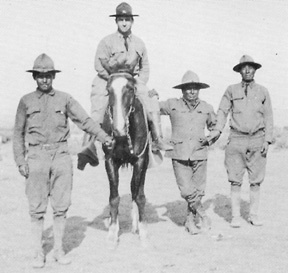
with Dr. McCloud, on horseback, at Fort Apache in 1918.
Some 39 Apaches, mostly Tontos, were part of the expedition, but they arrived too late to search for Villa. In fact, the attacks on Villa had been officially ended because the Mexican government had protested the presence of U.S. troops on Mexican soil. Nonetheless, Villista bands remained at large, and there was clean-up to be done. Apaches, in general, despised Mexicans, and they were eager to kill any, no matter who they were aligned with during the constantly changing allegiances of the Mexican revolution. Six of the Apache Scouts, armed with pistols rather than sabers, led the charge. None was killed, but 44 Villistas were.
In Mark Van de Logt’s 2010 book, War Party in Blue: Pawnee Scouts in the U.S. Army, Pawnee Scout leader Luther H. North is quoted as saying, “Neither the Wild Tribes, nor the Government Indian Scouts ever adopted any of the white soldier’s tactics. They thought their own much better.” Apache scouts were no different.
The Indian Scouts were not officially deactivated until the last member retired in 1947. Their memory lives in the cross-arrows insignia still worn on the uniforms of U.S. Army Special Forces with the motto: de oppresso liber, which in bad Latin has been taken to mean, “to free from oppression,” but more accurately means, “from the captured man is one made free,” rather ironic given the origin of the insignia.
Col. H.B. Wharfield, a lieutenant at the time of the Punitive Expedition, later wrote:
During my service in 1918 at Fort Apache the scouts wore cavalry issue clothing shoes and leggin[g]s, but some retained the wide car[tridge] belt of their own construction and design. An emblem U.S.S. for United State Scouts was fastened on the front of the issue campaign hat. The regulation emblem was crossed arrows on a disc with the initials U.S.S.; but I never saw such a design on the scouts’ uniform nor in the Quartermaster supply room.

On May 5, 1969, Navarre Scott Momaday (Kiowa-Cherokee) became the first American Indian to win the Pulitzer Prize for Fiction with his House Made of Dawn. That same year, “he was initiated into the Gourd Dance Society, the ancient fraternal organization of the Kiowas.” He went on to have a highly distinguished career as a writer and professor, having obtained his doctorate in 1965.
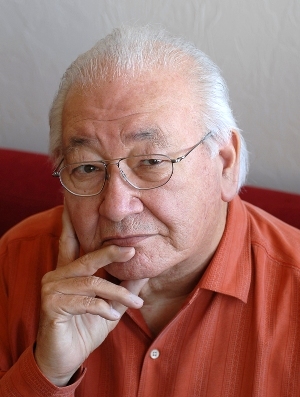
Included in his works: The Way to Rainy Mountain (1969), Kiowa tales illustrated by his father Al Momaday; Angle of Geese and Other Poems (1974); and a second volume of poems, The Gourd Dancer (1976); and a memoir, The Names (1976); The Ancient Child (1989); In the Presence of the Sun (1991); Circle of Wonder: A Native American Christmas Story (1993); and The Native Americans: Indian Country (1993); and a play, The Indolent Boys (2003).
His 1971 essay “The American Land Ethic” drew public attention to the tradition of respect for nature practiced by the native peoples and its significance to modern American society in an era of environmental degradation. It was partly written while he was lecturing in Moscow in 1974. At the same time, he took up drawing and painting seriously for the first time in his life. Since then his work has been exhibited throughout the United States. His newer books are frequently illustrated with his own paintings and etchings.
He has taught at Berkeley, Stanford and the University of Arizona. President George W. Bush awarded Momaday the National Medal of Arts in 2007 “for his writings and his work that celebrate and preserve Native American art and oral tradition.”

UN Special Rapporteur Calls for Restoration of Some Indian Lands
By Meteor Blades
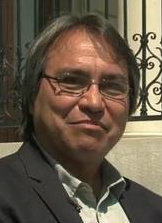
James Anaya, UN Special Rapporteur on the Rights of Indigenous Peoples, recently spent 10 days working his way across the country to examine the situation of Indians, Alaska Natives and Native Hawaiians. He held meetings with federal and state government officials, as well as with indigenous nations and their representatives. The first meeting was April 23 at the Navajo Washington Office in D.C. He also met that day in a closed-door session with elected tribal officials at the Embassy of Tribal Nations in Washington. It was a whirlwind afterward in six states, Oregon, Oklahoma, Alaska, Arizona, Washington and South Dakota.
Before he departed on Friday, Anaya said that restoring some lands, such as the Black Hills, to Indian control could help build reconciliation between Indians and non-Indians.
“The sense of loss, alienation and indignity is pervasive throughout Indian country,” Anaya said in a statement released Friday.
“It is evident that there have still not been adequate measures of reconciliation to overcome the persistent legacies of the history of oppression, and that there is still much healing that needs to be done.”
He pointed to the loss of tribal lands as a particularly sore point, naming the Black Hills of South Dakota and the San Francisco Peaks in Arizona as places where indigenous peoples feel they have “too little control.”
“Securing the rights of indigenous peoples to their lands is of central importance to indigenous peoples’ socio-economic development, self-determination, and cultural integrity,” Anaya said.
You can learn more about his mission and what he did on his first visits at his web site here.
What follows is testimony given by several Indians at various meetings with Anaya.
Debra White Plume’s (Oglala Lakota) testimony:
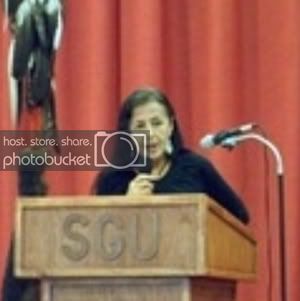 Debra White Plume
Debra White PlumeThere are uranium, oil, and gas corporations here now, and more want to come. We did not invite them. America welcomes Canadian-owned Cameco uranium corporation, TransCanada oil pipeline corporation, and PowerTech uranium corporation to come and obtain permits to mine uranium and slurry oil in our Territory against our wishes, this extraction and pipeline threatens our [Ogallala] Aquifer, which gives 2 million people drinking water and irrigates the world’s bread basket. We have not given our free, prior and informed consent as required by the Declaration of the Rights of Indigenous Peoples adopted by the United Nations General Assembly, we know not everyone is satisfied with the Declaration, but it is a minimum standards document.
Mr. Anaya, I ask you to keep this message clear, do not pretty up my testimony. I am saying that America is committing ethnocide against our way of life, eco-cide against our Mother Earth, and genocide in our Lakota Homelands. Our Human Rights are being violated and our Inherent Right to live as Lakota People and Nation is being violated as well. Without access to our lands and waters we cannot live our collective Inherent Rights to be who we are.
We must have our lands. Share this message with the world. The United States Supreme Court agreed our Territory was stolen by the United States and was the ripest, rankest case of land theft in the United States of America’s history and thus awarded us millions of dollars. Tell the world we refused the money. We want our lands and our waters. We want our Treaties upheld. We must have our lands.
In Tucson, Damon Watahomigie (Havasupai) testified: “As the first born warriors of the Grand Canyon we refuse to become the next millennium’s world terrorists by allowing mega nuclear industrial complex mining industries to mine in the Grand Canyon.”
As did Leonard Benally (Navajo):
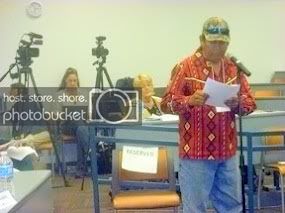 Leonard Benally
Leonard BenallyBen Shelly [president] of the Navajo Nation is working with Senator Kyl and McCain to pass legislation for the Little Colorado River Water Rights Settlement that gives away our water rights to Peabody Coal Company and Navajo Generating Station. We believe the Settlement is a tragedy not only due to the minimizing [of] Navajo rights but is waiving hundreds of millions of dollars in potential compensation for rights waived.
Our liberty is being sacrificed for an economic bonanza based on fraud and corruption. Our justice has been prostituted by hand-outs, hopelessness, and conformity elevated to the status of the national security doctrines. We are the historical lot of the dispossessed. Democracy has been whitewashed with imported detergent that allows reclaimed sewer water to get dumped on our sacred San Francisco Peaks.
Peabody’s collusion with the U.S. government has resulted in a dark infamy of genocide and crimes against my people and the environment – relocation, the Bennett Freeze, uranium mining, all in the pursuit of energy resource development fueled by corporate and governmental greed and collusion.
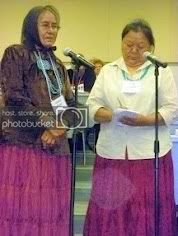
Fern Benally translating
From Glenna Begay (Navajo):
“Residents in the mining area have been jailed or threatened with jail for trying to protect their burial and sacred sites. Other residents have watched the unearthing of graves.”
From Hathalie [Medicine Man] Norris Nez (Navajo):
“In Big Mountain, Black Mesa, on Hopi Partition Land (HPL) there were many sacred sites where offerings were given.The Holy People, the Star People recognize us by these sites that are sacred where we Diné, five fingered humans give offerings. They acknowledge that we are doing our duty to give our offerings to the Holy People. These places are for the wellness of the people, not only the Diné. Our prayers are said for all mankind.”

“Ramp It Up” Exhibit Opens at the San Diego Museum of Man
By navajo
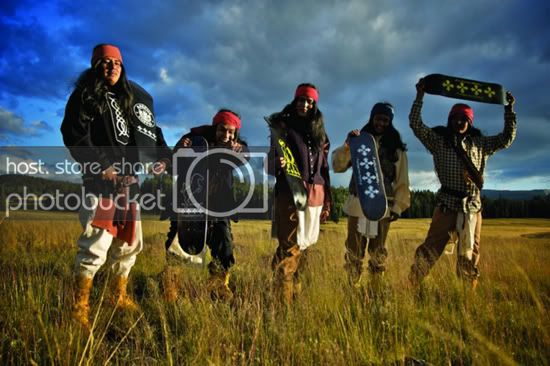
From left to right, White Mountain Apache skaters Armonyo Hume, Jess Michael Smith, Aloysius Henry, Ronnie Altaha and Lee Nash. The skate team was founded by award-winning filmmaker Dustinn Craig (White Mountain Apache/Navajo), who got his start making skateboarding videos in Arizona.
-Photo Courtesy Dustinn Craig (White Mountain Apache/Navajo)
Ramp It Up: Skateboard Culture in Native America
 Bryant Chapo (Navajo),
Bryant Chapo (Navajo),Minneapolis, Minn., 2007
Discovered by a local skateboard shop
in his hometown of Fort Hall, Idaho,
Bryant Chapo’s win at a 2006 Utah
skateboarding competition brought
him to national attention and his
first major sponsor. Chapo trains
and skates full-time and makes it
a point to participate in as many
Native skateboarding competitions
as he can. Here he performs a
varial heel flip.
-Photo Courtesy Brandon Flyg
Owing its origin to the surfboard of Native Hawaiians, the modern skateboard, or deck, grew in popularity on the mainland beginning in the 1960s. Since that time, skateboarding has become one of the most popular sports on Indian reservations and has inspired and influenced Native American and Native Hawaiian communities. Today, skateboarding is a five-billion-dollar industry that includes shoes, apparel, camps, music tours, reality TV, and worldwide competitions.
The lessons learned in a skatepark speak to the inner strength of each skater and are a metaphor for the Native experience: When you fall, get up and try again. Push yourself higher and faster. Never give up. Skateboarding has grown to become a true phenomenon, integrating physical exertion with design, graphic art, videography, and music. The result is a unique and dynamic culture all its own.
Ramp It Up: Skateboard Culture in Native America reveals the rich world of skateboarding and celebrates the vibrancy, creativity, and history of Native American skateboarding culture. Showing for the first time outside of the Smithsonian, this new traveling exhibition features rare images, video of Native American skaters, and over twenty skate decks created by Native artists.
Highlights include a never-before-seen 1969 image taken by skateboarding icon Craig R. Stecyk III of a skate deck depicting traditional Native imagery, as well as 1973 home-movie footage of Zephyr surf team members Ricky and Jimmy Tavarez (Gabrielino-Tongva tribe). The exhibition features the work of visual artists Bunky Echo-Hawk (Yakama / Pawnee), Joe Yazzie (Navajo), Traci Rabbit (Cherokee Nation of Oklahoma) and Dustinn Craig (White Mountain Apache / Navajo) and highlights young Native skaters such as Bryant Chapo (Navajo) and Augustin and Armondo Lerma (Agua Caliente Band of Cahuilla Indians).
Exhibit opened April 28, 2012 and runs through September 9, 2012.
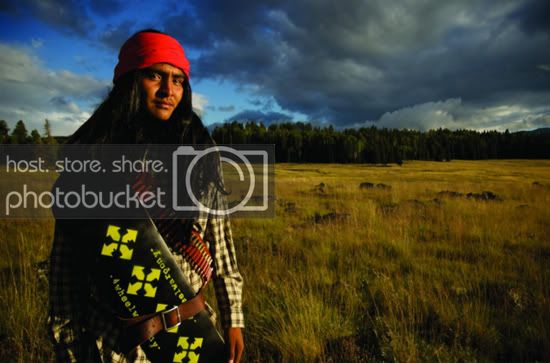
4-Wheel Warpony skater Lee Nash tucks a skate deck into his belt.
-Photo Courtesy Dustinn Craig (White Mountain Apache/Navajo)

Navajo Band and Jemez Pueblo Plan Major Solar Installations
By Meteor Blades
To’Hajiilee, N.M., home of a non-contiguous part of the Navajo Nation formerly known as the Cañoncito Indian Reservation, may soon be home to the largest commercial solar photovoltaic farm in the United States. if so, it will be 50 percent larger than the one Apple plans for its data center in North Carolina. Environmental reviews have been completed and found no significant negative impacts. All that remains before construction begins is getting contracts signed for power purchases
The 30-megawatt Shandiin operation on 250 acres of the 77,000-acre reservation will provide electricity for more than 6,000 homes. Shandiin means “sunbeams” in Diné, the language of the Navajo. With a population of only some 1700, the To’Hajiilee band will have plenty of extra electricity to sell power to the Public Service Company of New Mexico, which serves Albuquerque just 22 miles away. A major transmission line in close proximity to the site greatly reduces the cost of the project, but it is still estimated at $124 million. The band is thinking of selling electricity to municipalities, the federal government and directly to the PSCo.
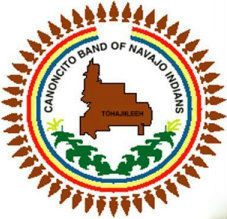
Meanwhile, the 3000-member Jemez Pueblo 25 miles further north is now in its third year of planning a $22-million commercial solar installation of its own. It’s a 4-megawatt project that will provide electricity to 1400 homes, on and off pueblo lands. That could ultimately bring in $1 million in revenue annually. Jemez Pueblo is also on the verge of drilling its first test well to see if geothermal power is practical for use on its lands.
Each solar project recently received for pre-construction purposes about $300,000 in federal grants from the U.S. Department of Energy’s Tribal Energy Program, sharing with other tribes their portion of a $6.5-million appropriation for 19 projects. Financing for construction of the solar farm will come from grants, private investors, tribal and pueblo resources, and loan guarantees. No completion dates have been set. But once power purchase agreements are arranged, construction could take as few as nine months. That means the Shandiin project could be generating electricity by May 2013.
“I think if we’re able to find a power buyer fairly quickly, we certainly ought to be breaking ground this fall. That’s our goal,” said Rob Burpo, president of First American Financial Advisors, Inc., one of the consulting groups working with To’Hajiilee.[…]
Her boots covered in fine yellow dust, Delores Apache, (To’Hajiilee band of Navajo) president of To’Hajiilee Economic Development Inc., walks across the spot where the solar panels will be situated.
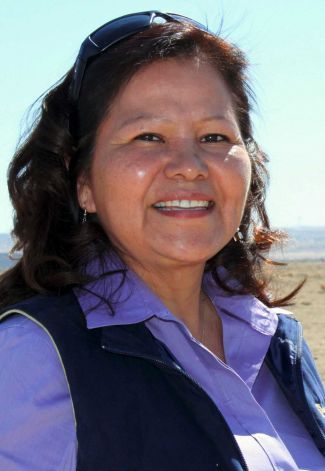 Delores Apache
Delores ApacheFor her, the project is about more than gaining a foothold in a new industry. She ticks off a list of what revenue from the plant would mean for her community: a daycare center, programs for senior citizens and veterans, better roads, more efficient wells for drawing water, language preservation programs and scholarships for youngsters.
“It’s going to mean a whole lot,” Apache said. “We have no means of economic development. No dollars. We don’t have anything at all.”
To’Hajiilee isn’t the only place Navajos hope to put up solar. The Navajo Nation, whose overall reservation spreads across 27,400 square miles, the size of Vermont, New Hampshire and New Jersey combined, is using its share of the recent DOE grant to explore the possibility of building solar farms totaling 4,000 megawatts on its lands in northwest New Mexico. That would double the existing level of commercial solar photovoltaic electricity operations in the entire United States and generate enough power for 800,000 homes.
In a Washington and Lee Law Review article last year, attorney Ryan Dreveskracht wrote:
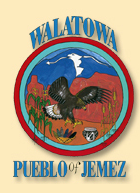
“Solar projects can be a rallying point, allowing tribes to come together collectively to pursue their own objectives in their own way, promoting cultural awareness, and creating a self-image that has been missing in many communities for years.”
But there are profound concerns among leaders and other members of tribes that have been screwed for centuries by outsiders who told Indians what their best interests were and then proved self-interest was the real motive by ripping off the tribes. So when the talk is about outside investors putting up money for energy projects, the bullshit antennae start vibrating like crazy. For this reason, “Tribes need to … establish clear business plans, and create knowledgeable workforces of their own,” Dreveskracht wrote.
The Department of Interior hopes to open more public land for wind and solar projects, but these often run into opposition, sometimes from environmentalists worried about damage to endangered fauna and flora, sometimes from residents for NIMBY reasons. These objections can generate lawsuits that take years to wind their way to settlements or court judgments. Tribal lands, however, are governed under different rules and an increasing focus on Indian sovereignty has meant tribes have more latitude to make their own decisions in the matter of energy and other projects.
A new Department of Interior rule will fast-track leasing agreements on Indian trust lands, giving more power to the tribes and curtailing oversight by the Bureau of Indian Affairs. But it is seen as a double-edged dagger. While it is designed to slice through red tape that has stalled tribal decision-making, it can also lead to corruption and yet more rip-offs.
While Indian lands hold the potential to supply four times as much electricity as needed by the entire nation, most of that land is in the West and Far West, putting it out of reach of Eastern markets, at least until low-leakage Ultra-High Voltage transmission lines are in place, which could be a long time. And so far, politics and other foot-dragging have kept solar projects from happening. Now, however, with prices for solar cells continuing to make steep drops and the financial and other support of the Obama administration, projects like those at To’Hajiilee and the Jemez Pueblo aren’t the only ones likely to come on line in the next decade.
And solar isn’t the only renewable source making headway. The Kumeyaay of Campo in southern California have installed 25 wind turbines that on a good day generate 50 megawatts of electricity, far more than the small tribe needs for its own use. It plans to install an additional series of turbines capable of generating another 160 megawatts or electricity. The total would be enough to provide power for 50,000 homes.

• Colorado Legislature Opts for “Atrocity” Instead of “Genocide”: State Sen. Suzanne Williams (Comanche) thought that the resolution she introduced in the Colorado legislature would be met with the same strong support given to resolutions condemning Jewish, Armenian and Darfurian genocides. Hers, however, being about American Indian genocide, “hit a little too close to home.” That spurred a debate among legislators that went largely along party lines. Williams is a Democrat. Republican Sen. Ellen Roberts and others argued that there had been no Hitler-like extermination plan and Indians aren’t extinct, so “genocide” was inappropriate. But Williams argued that there was an extermination plan, one that stretched from the nation’s origin through the Trail of Tears, massacres like that in 1864 at Sand Creek in Colorado and confinement on barren reservations where thousands of Indians died from harsh conditions. She said the resolution described “a history of what happened in North America.” She couldn’t convince her colleagues. Amendment after amendment was offered to substitute another word for “genocide.” Eventually, it could be said a middle ground was chosen by nixing both “tragedy” and “genocide” in favor of “atrocity.” Even so, nine of the 33 senators present opposed the resolution.
-Meteor Blades
• Honor the Treaties Campaign Hurt by Poster Giant’s Negligence: Aaron Huey of the Honor the Treaties campaign hired Poster Giant to paste up posters in the Seattle streets last year. The company reported more than four months ago that all posters had been put up and its stock depleted. Recently, numerous complaints from alternative street artists in Seattle revealed that Poster Giant did have inventory of Honor the Treaties posters because it had pasted over several existing murals, causing an uproar. Honor the Treaties and Aaron Huey’s reputation was damaged and is as much a victim as are all the street artists who lost their original artworks as a result of Poster Giant’s mismanaged services. Huey is considering what he can do to rectify the situation.

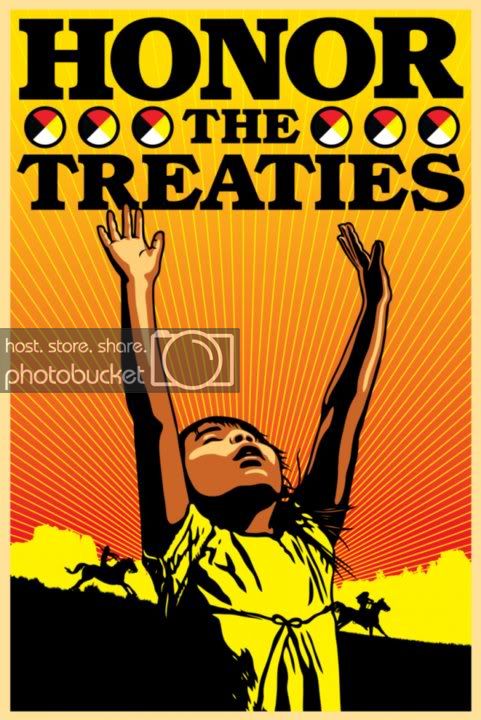
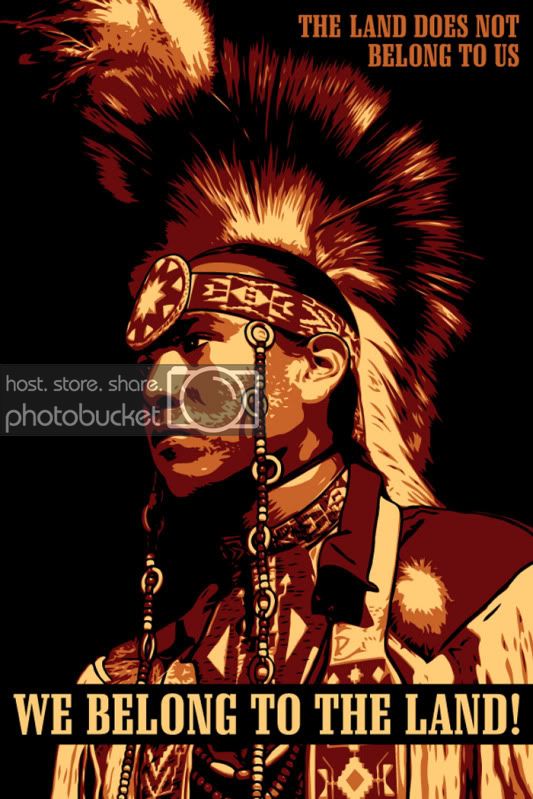
On a positive note for Honor the Treaties, the posters are getting righteous visibility around the nation being used by activists at the XL Pipeline protests.
-navajo
• Blind Lakota Man Scarred with “KKK” at Hospital: Sixty-eight-year-old Vernon Traversie (Cheyenne River Sioux), had heart surgery in Rapid City Regional Hospital in South Dakota. He spent two weeks in recovery. He said that during this time a nurse named “Greg” refused to give him pain medication. After he was discharged, a co-worker told him he should have photographs taken of his stomach because someone had carved or burned the “K’s” on him, the acronym of the racist Ku Klux Klan. Tribal police took their own photos and sent copies to Rapid City police. They investigated but filed no charges. The FBI told him they were going to take a statement, but Traversie says he hasn’t heard from them in months. He plans to file a lawsuit. The chairman of the Confederated Tribes and Bands of the Yakama Nation has written a scathing letter regarding the incident.
-Meteor Blades
• Obama Replaces Kimberly Teehee with Jodi Gillette in Native American Affairs Post

President Barack Obama has announced the appointment of Jodi Gillette (Standing Rock Sioux) as Senior Policy Advisor for Native American Affairs, replacing Kimberly Teehee, who held the job since it was created in 2009. Teehee, who was said to be interested in the post of Assistant Secretary of Indian Affairs vacated in April by Larry Echo Hawk (Pawnee), has moved to private, Indian-focused lobbying firm, Mapetsi. As a member of the Domestic Policy Council, Gillette will advise the president on issues impacting Indian Country. “Jodi Gillette will be an important member of my Administration’s efforts to continue the historic progress we’ve made to strengthen and build on the government-to-government relationship between the United States and tribal nations,” said Obama. “She has been a key member of my administration’s efforts for Indian Country, and will continue to ensure that Native American issues will always have a seat at the table.”
Gillette was previously the Deputy Assistant Secretary to the Assistant Secretary-Indian Affairs for Policy and Economic Development in the U.S. Department of the Interior. Earlier she served as Deputy Associate Director of Intergovernmental Affairs and Associate Director of Public Engagement, where she was responsible for the communication and interaction between tribal nations and the White House. She played a key role in the White House Tribal Nations Conference in 2009 and 2010, where the president hosted tribal leaders from across the U.S. She has also served as executive director of the Native American Training Institute in Bismarck, N.D., a nonprofit offering technical assistance and training to tribal, state and local governments in the area of human service delivery systems. She also had served as an economic development planner for her tribe in Fort Yates, N.D. Gillette holds a BA in government and Native American Studies from Dartmouth and a Master’s in public Policy from the University of Minnesota’s Humphrey School of Public Affairs in Minneapolis.
-navajo
• Professors File Lawsuit to Stop Transfer of Bones: The Kumeyaay tribe of southern California has been seeking to have the bones of a human male and female found buried in 1976 on a cliff in their traditional territory returned to them under provisions of the Native American Graves Protection and Repatriation Act. The University of California, San Diego was prepared to do so, but a lawsuit has been filed to stop the transfer. Three anthropology professors claim that collagen taken from skeletons, dated to about 10,000 years ago, indicates that the individuals ate ocean fish and mammals different than traditional fare eaten by ancestors of the tribe. James McManis, a lawyer for the trio said: “These are not Native Americans. We’re [not] sure where they’re from. They had primarily a seafood diet, not the diet of any way of these tribes. They were a seafaring people. They could be traveling Irishmen who touched on the continent. The idea that we’re going to turn this incredible treasure over to some local tribe because they think it’s Grandma’s bones is crazy.” Of the skeletons, one of the professors, anthropologist Tom Bettinger, says “No other set of New World remains holds such a high degree of research potential.” (You can read our previous coverage of the issue here.)
-Meteor Blades
• CSU-San Marcos Honors 24 Indian Graduates: The California State University campus celebrated the two dozen students, the most in the school’s 21-year history, who will complete undergraduate or masters degrees this year. The university has made a goal of increasing enrollment of American Indian students by reaching out to tribal schools, recruiting high school students from area tribes, and adding the California Indian Culture and Sovereignty Center in November.
-Meteor Blades
• Navajo Student Improves Indian Sustainability Program with Her Dissertation: Fonda Walters (Navajo) and her five siblings are first-generation college graduates who now include two with a PhD after their names. She graduates in June after having worked on a dissertation focused on “First Innovations” a collaboration between the American Indian Policy Institute in Phoenix, Ariz., and the American Indian Studies program at Arizona State University that combines an intensive internship with classes focused on developing innovation and entrepreneurial skills for American Indian sustainability. It wasn’t easy. She had children ranging from age 8 to 17 when she started her doctorate in 2009. “I went to my family for guidance and help. We held traditional ceremonies to get me through while we were doing this,” she said. “This is my family’s degree … They stayed up all night for me.”
-Meteor Blades
• Eight Lakota Students Warn Against Delays in Nickname Lawsuit: The students at the University of North Dakota have urged a federal court “move as expeditiously as possible to prevent further violations of (their) civil rights.” They oppose the university’s continued use of the “Fighting Sioux” nickname and logo for its sports teams. The lawsuit is one of two. On May 2, a federal judge dismissed the second suit brought by the Spirit Lake Sioux Tribe, which favors keeping the nickname. The lawsuits were brought as part of a longstanding battle over the use of Indian nicknames, mascots and logos on sports teams. The NCAA has forbidden their use unless relevant tribes give their approval.
-Meteor Blades
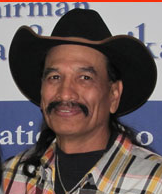
• Death of Rare White Buffalo Under Investigation: The slaying and skinning of Little Medicine Cloud, the just-shy-of-its-first-birthday white buffalo whose birth generated widespread jubilation and celebration among Lakota and other Plains tribes, is being investigated by Texas Rangers and the Hunt County Sheriff’s Department. A reward of $5000 for information leading to convicting whoever is responsible has been posted. It is believed the killer cased the ranch and waited until the owner, Arby Little Soldier (Fort Berthold-Three Affiliated Tribes), was gone. He said a scholarship-raising pow-wow scheduled for the buffalo’s birthday celebration this coming week will take place anyway. Traditional Lakota believe the goddess of peace has appeared in the form of a white buffalo calf and that the white animals serve as a unifying force for all nations.
-Meteor Blades
• New Mexico Indians Have Substantial Voting Clout: The question is whether they will use it. Alvin Warren (Santa Clara Pueblo), principal and executive vice president of Blue Stone Strategy Group, was a panelist at the recent WK Kellogg Foundation’s grantee conference for America Healing in New Orleans. Warren noted that American Indians can have significant voting clout in New Mexico, which is an important swing state in presidential elections. “In New Mexico, he said, we actually have had very similar experiences to the South when it comes to discriminative, active and intentional, systemic and institutional, with regard to native voting.” The American Indian population in New Mexico increased from 134,000 in 1990 to almost 220,000 in 2010, approximately 11 percent of the state’s population. With this percentage of the total population, American Indians can have tremendous impact and influence, according to Warren.
-Meteor Blades
• Malkin’s Demeaning of Indians Catch Native Journalists’ Ire: Michelle Malkin has made a living attacking people of color, so it was no surprise that she would take on the controversy surrounding the Indian heritage of Elizabeth Warren with her usual sensitivity. Taking a far gentler approach than Malkin deserved, the Native American Journalists Association issued a statement saying it was “disappointed” that she had written a piece under the headline “Sacaja-whiner: Elizabeth Warren and the Oppression Olympics” and ridiculed the Senate candidate with denigrating puns and other put-downs: “Call her ‘Pinocchio-hontas,’ ‘Chief Full-of-Lies,’ ‘Running Joke’ or ‘Sacaja-whiner.’” NAJA stated: “While allegations surrounding [Warren’s] claims are unsettling, making fun of Native names that have history, respect, and honor is worse.” Meanwhile, Megyn Kelly on Fox News told Shepard Smith that she would like to interview Warren and knew exactly the way she would begin. She then raised her hand and said “How.” Afterward, she broke into laughter and said she had been drinking. At least she didn’t say, “Firewater very powerful.”
-Meteor Blades
• Map Gives Possible Clues to Roanoke’s ‘Lost Colony’: The disappearance of the English colonists who first tried to settle on Roanoke Island off the coast of present-day North Carolina has been an unsolved mystery since 1590. The disappeared include Virginia Dare, the first English child born in North America. Theories abound as to what happened to the 118 colonists between the time their governor sailed for England in 1587 to obtain new supplies and 1590 when he returned to find them all gone and their village and fortifications dismantled. Theories abounded for years: starvation; disease; lost at sea; wiped out by local Indian tribes; captured, enslaved and/or assimilated by local tribes. The Lost Colony DNA Project seeks to test these latter possibilities. Now, the British Museum’s use of 21st Century imaging methods to reexamine a 16th-century map has found hidden markings “that show an inland fort where the colonists could have resettled after abandoning the coast. […] The analysis suggests that the symbol marking the fort was deliberately hidden, perhaps to shield it from espionage in the spy-riddled English court. An even more tantalizing hint of dark arts tints the map: the possibility that invisible ink may have marked the site all along.”
-Meteor Blades
• The Book of Mormon: The Whiter the Skin, the Closer to God: Tim Giago (Oglala Lakota), founder of the Native American Journalists Association and Indian Country Today, and widely considered to be an enemy of Indian militance, points out in a recent article racist quotes of past presidents of the Mormon Church regarding Native Americans. From Brigham Young: “There is a curse on these aborigines of our country who roam the plains and are so wild that you cannot tame them. They are of the House of Israel; they once had the Gospel delivered to them, they had oracles of truth; Jesus came and administered to them after his resurrection and they received and delighted in the Gospel until the fourth generation when they turned away and became so wicked that God cursed them with this dark and benighted and loathsome condition.” Giago’s conclusion was the same as ours in FNN&V two weeks ago. “And I will continue to ask myself why any sensible Native American would belong to a Church that will not fully accept them until they become white.”
-navajo
Indians have often been referred to as the “Vanishing Americans.” But we are still here, entangled each in his or her unique way with modern America, blended into the dominant culture or not, full-blood or not, on the reservation or not, and living lives much like the lives of other Americans, but with differences related to our history on this continent, our diverse cultures and religions, and our special legal status. To most other Americans, we are invisible, or only perceived in the most stereotyped fashion.First Nations News & Views is designed to provide a window into our world, each Sunday reporting on a small number of stories, both the good and the not-so-good, and providing a reminder of where we came from, what we are doing now and what matters to us. We wish to make it clear that neither navajo nor I make any claim whatsoever to speak for anyone other than ourselves, as individuals, not for the Navajo people or the Seminole people, the tribes in which we are enrolled as members, nor, of course, the people of any other tribes.
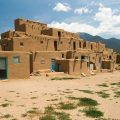
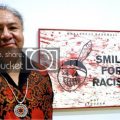
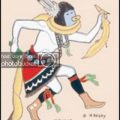

Leave a Reply